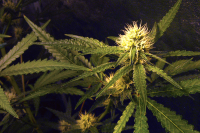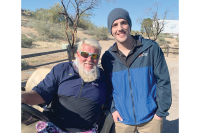Celebrating Kephart, and his teacup
This past weekend marked the second annual Horace Kephart celebration in Bryson City. There was a terrific presentation of newly surfaced George Masa photographs moderated by Masa biographer Bill Hart. Daniel Gore brought his band from Washington State to play the Kephart tunes in the album “Ways That Are Dark.” Folk musician Lee Knight played and sang. Park superintendent Dale Ditmanson spoke at the graveside service in uniform but quickly reappeared downtown in a T-shirt and shorts. There was talk of moving Masa’s remains from Asheville to a place beside Kephart in Bryson City. I’ll oppose that notion. “Leave George Be” will be my anti-removal slogan. He’s been at rest in Asheville, where he lived and worked, for 75 years.
That’s about it ... except for the Kamp Kephart five-man contingent from the Schiele Museum of Natural History in Gastonia, N.C., which pitched their period demonstration camp near the railway depot.
Kamp Kephart is an educational workshop dedicated to late-19th and early-20th century campcraft and woodcraft and is named in honor of Horace Kephart, outdoorsman and author of Camping and Woodcraft, one of the cornerstones of American outdoor literature. Kamp Kephart leader Steve Watts asserts that the book is “no mere out-of-date period piece, but rather a viable guide with great relevancy for the 21st century.”
I spent a lot of time with the Kamp Kephart crowd at their “camp site” and later on in my office. A visit to this web site will give you an idea of what they’re up to in regard to presentations of period dress, equipment, etc: http://zombiehunters.org/forum/viewtopic.php?f=34&t=43874
But they also think a lot about what they’re up to philosophically and spiritually. My last question of them was: “Which item of Kephart’s camping equipment would you like to find and have?”
“His tea cup,” one of them said. I knew exactly what he was talking about. You’ll find the “Kep’s teacup” on pages 111-112 of the first volume of Camping and Woodcraft:
Related Items
“In his charming book, The Forest, Stewart Edward White has spoken of that amusing foible, common to us all, which compels even an experienced woodsman to lug along some pet trifle that he does not need, but which he would be miserable without. The more absurd this trinket is, the more he loves it. One of my camp-mates for five seasons carried in his “packer” a big chunk of rosin. When asked what it was for, he confessed:
“Oh, I’m going to get a fellow to make me a turkey-call, some day, and this is to make it ‘turk.’ “ Jew’s-harps, campstools, shaving-mugs, alarm-clocks, derringers that nobody could hit anything with, and other such trifles have been known to accompany very practical men who were otherwise in light marching order. If you have some such thing that you know you can’t sleep well without, stow it religiously in your kit. It is your “medicine,” your amulet against the spooks and bogies of the woods. It will dispel the koosy-oonek. (If you don’t know what that means, ask an Eskimo. He may tell you that it means sorcery, witchcraft — and so, no doubt, it does to the children of nature; but to us children of guile it is the spell of that imp who hides our pipes, steals our last match, and brings rain on the just when they want to go fishing.)
No two men have the same “medicine.” Mine is a porcelain teacup, minus the handle. It cost me much trouble to find one that would fit snugly inside the metal cup in which I brew my tea. Many’s the time it has all but slipped from my fingers and dropped upon a rock; many’s the gibe I have suffered for its dear sake. But I do love it. Hot indeed must be the sun, tangled the trail and weary the miles, before I forsake thee, O my frail, cool lipped, but ardent teacup!”
It would be nice to have that handless teacup in a museum ... but I also like the idea that’s it’s still out there ... maybe up in the old cabin at High Rocks . . . or tucked away behind a boulder in Bone Valley ... or somewhere back in Nicks Nest ... waiting for the right person, in the right frame of mind, to come along, pick it up, and say to himself or herself, “Kep’s teacup.”
George Ellison wrote the biographical introductions for the reissues of two Appalachian classics: Horace Kephart’s Our Southern Highlanders and James Mooney’s History, Myths, and Sacred Formulas of the Cherokees. In June 2005, a selection of his Back Then columns was published by The History Press in Charleston as Mountain Passages: Natural and Cultural History of Western North Carolina and the Great Smoky Mountains. Readers can contact him at P.O. Box 1262, Bryson City, N.C., 28713, or at This email address is being protected from spambots. You need JavaScript enabled to view it..









